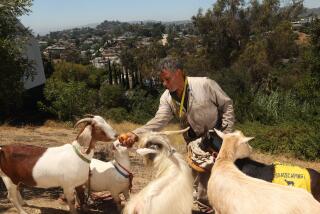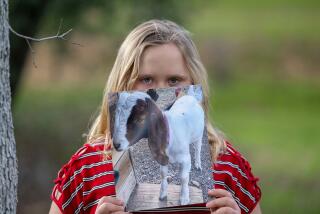Cashmere Goats Gain a U.S. Foothold : Farming: Early efforts to raise the animals for their fur faltered due to diplomatic barriers and import curbs. The federal government is now funding a pilot project.
- Share via
LEBANON, Conn. — When farmer Peter Sellew told his friends he planned to breed Australian cashmere goats, they thought he was crazy.
Only a handful of farmers in the region had ever tried to raise the animals.
“Now they call up and say, ‘How can we get some of those goats?’ ” said Sellew, who left his job at a book publishing company 15 years ago to become a farmer.
In 18 months, Sellew, 62, has built his stock from five imported goats to a herd of nearly 100. This spring, he expects to sell their soft cashmere fleece for up to $45 a pound, contrasted with about 85 cents a pound for sheep’s wool.
Cashmere, which is used to make luxurious sweaters, scarves and suits, is the fine down undercoat of the goat. The animals were named for the Kashmir region of southern Asia, where they are indigenous.
Since he began exhibiting his goats at town fairs, more than 50 farmers from across the state have approached him about getting into the business, Sellew said.
Farmers who raise the goats say earlier attempts had been quashed by poor diplomatic relations with some of the main producers of cashmere--including Iran, Afghanistan and China--and stringent U.S. government restrictions on importation of farm animals.
Judith Richardson, who runs a herd of about 300 cashmere goats in Silver Creek, Wash., began researching U.S. production 13 years ago. But it wasn’t until two years ago that she saw any real interest.
Richardson imported cashmere goats from the island of Tasmania, located off the coast of Australia. She built up her herd through breeding and now sells bred does for about $3,000 each. Last year, she sold $400,000 worth of cashmere goats.
While interest in producing cashmere has been slow to grow in the United States, Richardson sees that changing.
The fledgling industry received a boost from the government last year when the U.S. Department of Agriculture awarded Richardson a $500,000 grant to study the potential for raising cashmere goats in the United States.
As part of the project, 15 test farms from Washington to Maine were chosen to raise the animals. The pilot project includes implanting the embryos of cashmere goats into Angora goats.
Richardson said many farmers are attracted to the new industry because goats are easy to raise, require almost no care and need very little food.
For farmers like Sellew, the goats also double as weed killers, eating everything from ragweed to poison ivy.
“I love the animals. They just mow everything down,” said Sellew, showing off a rocky pasture he said was covered with thick weeds and brush before the goats arrived.
Although many farmers are being lured by the big money they assume can be made from the luxury fiber, industry experts warn that breeding goats to produce cashmere is far from a guaranteed moneymaker.
Because there is no true cashmere goat breed, farmers normally start with foreign imports--mainly from Australia and New Zealand--and then breed them to build a large herd.
The imported goats sometimes produce Angora instead of cashmere, Richardson said. There also is lingering skepticism among farmers about goats, a much-maligned animal known for its mischievous nature.
“A lot of people still think goats eat tin cans and jump on top of cars,” said Ann Dooling, a Connecticut native whose 600-goat herd in Dillon, Mont., is one of the largest in America. “Actually, goats are a very useful animal, and if someone approaches this carefully, they can do very well.”
American cashmere production is so new that the USDA does not keep statistics on production.
But Cashmere Producers of America Inc., a national industry group formed two years ago, has attracted more than 200 members, most of whom are raising goats to produce cashmere.
“There’s some real potential for it to really take off here,” said Jill Darrah, who has 700 cashmere goats on her Longmont, Colo., ranch.
Although the United States currently has only a handful of mills that process American cashmere, that is expected to change as more farmers begin breeding goats.
Forte Cashmere Co. Inc. of Woonsocket, R.I., in only its second year of purchasing American-produced cashmere, bought 1,400 pounds this year, more than three times as much as last year, said company Vice President James Coleman.
Even with such growth, Sellew still is something of a pioneer on the East Coast, where the idea has not caught on as quickly as it has in the West.
Sellew, who already has pumped $100,000 into his business, estimates that he will make only about $5,000 from his first shearing. He hopes to make a more substantial return on his investment by breeding and selling the goats for $2,000 each to other interested farmers. Even at that, he said it will take him at least three years to make a profit.
Sellew takes it all in stride.
“It’s always great to start something new and have people say you’re a nut, when you know it’s going to be successful,” he said. “I think it’s going to really take hold.”
More to Read
Sign up for Essential California
The most important California stories and recommendations in your inbox every morning.
You may occasionally receive promotional content from the Los Angeles Times.













